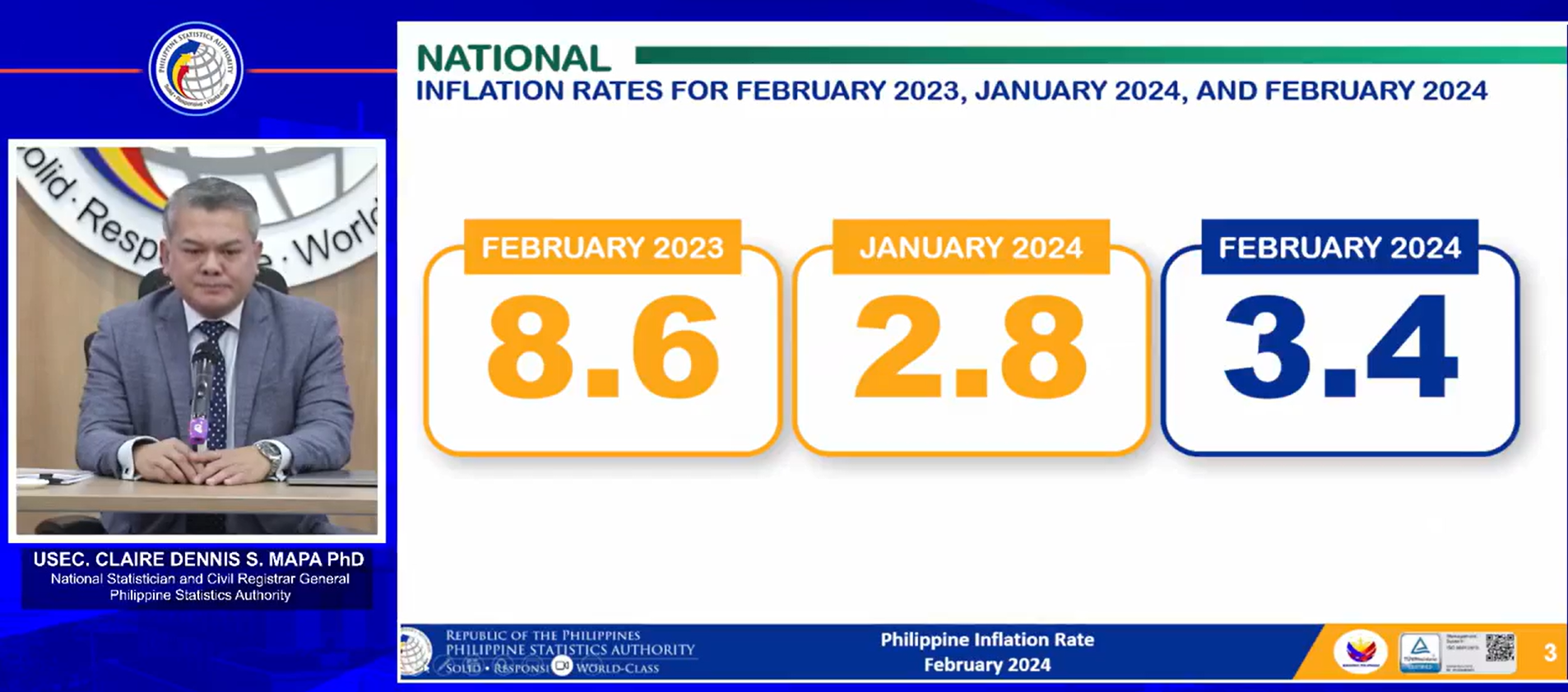
By Brian Jules Campued
The headline inflation in the country quickened to 3.4% in February 2024, faster than the 2.8% recorded in January but still significantly slower than February 2023’s rate of 8.6%, the Philippine Statistics Authority (PSA) announced Tuesday.
In a press briefing, National Statistician and PSA Usec. Claire Dennis Mapa reported that the uptrend was influenced by the higher year-on-year increase in food and non-alcoholic beverages (from 3.5% in January to 4.6% in February) as well as the annual increase of transport (from 0.3% in January to 1.2% in February).
Mapa said that housing, water, electricity, gas, and other fuels also contributed to the uptrend in overall inflation, as it recorded a quicker increase of 0.9% from 0.7% in January.
PSA also noted a higher inflation rate in alcoholic beverages and tobacco at 8.6% in February from 8.4% in the previous month.
Inflation was also higher among the poor who make up the bottom 30% of the population at 4.2% from 3.6% in January.
Mapa also said the inflation rate in the National Capital Region (NCR) likewise rose to 3.2% in February from 2.8% in the previous month.
“Following the trend at the national level and in NCR, overall inflation in AONCR (areas outside NCR) also showed an uptrend at 3.5% in February 2024 from 2.8% in January 2024,” PSA data showed.
Meanwhile, core inflation, which excludes certain food and energy items, also eased to 3.6% in February from 3.8% in January.
Food inflation went up to 4.8% in February from 3.3% in January–particularly, rice inflation rose to 23.7% from 22.6% during the same period, which was the highest since the 24.6% recorded in February 2009.
Mapa said that the rice inflation is the “major contributor to overall inflation and the inflation of the bottom 30% income households” and attributed the uptick to high prices in the world market and tight supply.
According to Mapa, rice inflation contributed 1.6 percentage points in the computation of the headline inflation and 3.3 percentage points in the inflation among the bottom 30% income households.
Average prices of different rice classes for February monitored by the PSA: about P50.44 per kilogram (kg) of regular-milled rice, P55.93/kg of well-milled rice, and P64.42/kg of special rice. All prices increased from January’s registered average for the respective variants of rice.
“All three types of rice that we are tracking ay nakita nating tumaas year-on-year at saka month-on-month,” Mapa stated.
He explained that the higher rice inflation was due to the low base effect or the lower rice inflation rate recorded from January to July 2023.
“So assuming na no reduction with the price and the movement will continue, we should be expecting high rice inflation until July or August this year,” Mapa said.
‘Still within the target range’
The inflation rate last month was within the 2.8% to 3.6% forecast of the Bangko Sentral ng Pilipinas (BSP).
“This inflation outturn is consistent with the BSP expectations that inflation will likely remain within the target range in Q1 (Quarter 1) 2024 due largely to negative base effects,” the central bank said in a statement.
However, the BSP also advised the public that inflation could temporarily accelerate in the second quarter due to the effects of El Niño on agricultural production and positive base effects.
Department of Finance Sec. Ralph Recto underscored that the government is prepared to mitigate the effects of El Niño on inflation, adding that reducing inflation and protecting the purchasing power of Filipinos are prioritized by the Marcos administration.
“The government has a comprehensive plan in place––the Reduce Emerging Inflation Now or REIN––to keep the prices of goods and services stable and affordable. The deliberate implementation of REIN will help us keep the inflation rate within manageable levels, especially with the looming threat of El Niño,” Recto said in a statement.
Other government interventions in place mentioned by Recto was the P455.59 million budget for the implementation of the Rice Competitiveness Enhancement Fund during the first quarter of 2024 to support farm productivity and ensure food security.
“The government will also continue the distribution of Fertilizer Discount Vouchers as measures to sustain crop production amidst El Niño,” the DOF statement read.
Trade Sec. Alfredo Pascual also assured the public that the higher inflation rate was taken “in broader context” of the dynamic global and domestic economic environment.
“Underpinned by robust fiscal and monetary policies, we are well-prepared to navigate through these inflationary pressures. We remain steadfast in our balanced approach to economic management — sustaining economic growth while ensuring price stability,” Pascual said.
National Economic and Development Authority Sec. Arsenio Balisacan added that the government will continue to monitor food supply and prices as well as implement necessary policies and strategies to ensure affordable prices.
“As we navigate the economic landscape, it is imperative that we remain vigilant and proactive in our approach to managing inflationary pressures…our team is actively formulating robust strategies with the concerned agencies in response to these challenges. We must be agile, adaptive, and forward-thinking,” Balisacan stated.
The government’s chief economic planner added that the Department of Agriculture is working closely with the International Rice Research Institute to boost rice production in the country while the next phase of the vaccine test for African Swine Fever is awaiting Food and Drug Administration approval. – avds
